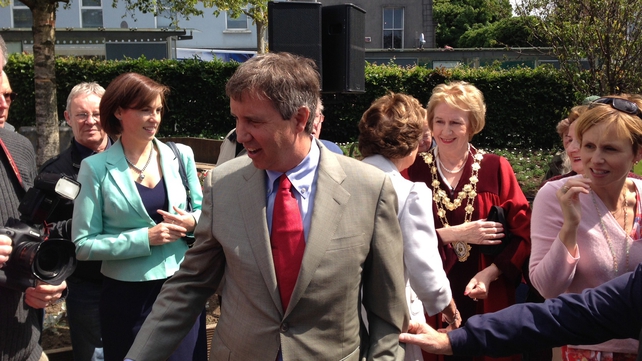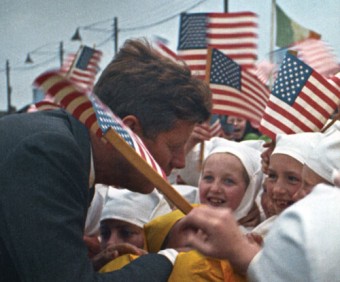Ireland is now a nation of pagans according to Irish Bishops
Most Irish bishops believe we have become a “nation of pagans” who bought in to the “evils of materialism and consumerism” of the Celtic Tiger era.
A report from the Association of Catholic Priests (ACP) also claims there is a strong view among ecclesiastical authorities that falling vocations and Mass attendance figures are a result of people “not having time or interest in faith”, rather than as a result of any of the clerical sex abuse scandals to rock the Church.
It also found the vast majority of priests believe the controversial New Missal is “very unsatisfactory”.
The ACP report, published yesterday after its first series of nationwide meetings with priest councils, said the bishops believe that evangelisation and re-education is needed — but it warned against relying on ageing priests to renew the Church.
“The age, lack of energy, tiredness of priests was very obvious. Expecting these men to bring about any real change was clearly not living in the real world. Keeping the show on the road for another few years is the most that can be expected from most of them.”
ACP founder Fr Tony Flannery has warned that without urgent action, Ireland could be without priests within 20 years.
“They [the bishops] don’t seem to grasp the urgent need to tackle falling vocations which could see most Irish parishes without a Catholic priest within 20 years. It’s not true of them all. We had an excellent meeting with [Archbishop of Dublin] Dr Diarmuid Martin and some of the bishops were quite open to our suggestions.
“But we are facing a crisis — a situation where there will be no priests in this country within 20 years. And we can’t claim then that we didn’t see it coming. What is most striking though is that there is no sense of urgency to do something about it.”
In its report, the ACP said the present paradigm of priesthood is no longer working and proposed bringing back those men who left the priesthood to get married, and choosing viri probati (mature men of standing) in the parishes to undergo the same training used for the diaconate.
However, the ACP said there was disagreement about its analysis.
The report said there seems to be a substantial number of bishops, and some priests, who believe that the problems facing the Church are not due to any difficulties in the Church or with the priesthood, but are caused by a lack of faith in the people.
“The people, they told us, have bought into the evils of materialism and consumerism, and don’t have time or interest in faith any more,” said the report.
“They have, to all intents and purposes, become pagan. And they believe that ‘evangelisation’ is the answer. It is a convenient belief, in that the blame lies elsewhere than among ourselves. We consider there are real problems here for the Irish Church.
“If there are such radically different understandings of the current situation, it is hard to see how we can make headway in working towards a solution.”
The report also said that almost every priest agreed the New Missal was “very unsatisfactory” and “a hindrance” in the proper celebration of the Eucharist.
“One or two bishops tried to defend it, but most also agreed that it was not a good development,” said the report.
NAMA is keeping a close eye on battle for former Treasury assets
AGENCY HAS INDIRECT INTEREST IN THE PROPERTIES
NAMA is “monitoring closely” the increasingly bitter takeover battle for 16 former Treasury Holdings buildings in Dublin and Cork, the Irish Independent has learned.
The National Asset Management Agency was thought to have exited any involvement in the portfolio that includes the Stillorgan Shopping Centre and Bank of Ireland’s Dublin headquarters when it sold an €85m junior loan secured on the buildings earlier this year to US-based Northwood Partners for a rumoured €100,000.
But sources in Dublin say NAMA managers will be watching Wednesday’s vote with interest because they kept an indirect interest in the loan even after the sale.
The battle for the property portfolio – dubbed Opera Finance CMH – is set to come to a head on Wednesday when bondholders who seized the trophy buildings over unpaid debt are due to vote at a meeting in London on whether to back a €306m sale to US buyer Kennedy Wilson.
RIVAL
Bondholders could try to block that deal after a rival €311m offer from Northwood Partners was launched last week. Northwood claims its offer protects the sellers from a potential multi-million euro capital gains tax bill.
Blocking the Kennedy Wilson deal may not be possible, however. German bank Eurohypo, which is the “servicer” of the complex debt structure secured on the buildings, has indicated it will push through a sale to Kennedy Wilson after 52pc of the subset of borrowers with the best claim on the sale proceeds backed that offer.
Bondholders are owed €375m, so some of the lenders will suffer a loss when the sale goes through.
NAMA’s “indirect” involvement is though to mean that if Northwood can unseat Kennedy Wilson in the takeover chase, the State could potentially claw back additional cash down the line by sharing any profits from what is now the most sought-after property deal since the crash.
The 16 buildings also include Merchants Quay Shopping Centre in Cork, and a plethora of high-end Dublin office blocks such as the FAS offices on Baggot Street, and KPMG’s main Dublin offices.
Northwood was an underbidder in the initial process to sell the assets that had looked to be over last month. In May, a subcommittee of the lenders recommended a joint offer from US investors Kennedy Wilson and Varde of €306m.
Douglas a nephew of John F Kennedy visits Galway city for 50th Anniversary


A nephew of John F Kennedy has said that something special happened to his uncle during his four-day visit to Ireland in 1963.
Douglas Kennedy was speaking at an event in Eyre Square in Galway this afternoon to mark the 50th anniversary of the late president’s visit to the city.
Mr Kennedy, the youngest son of Senator Bobby Kennedy, said he had always been told about the visit when he was growing up.
He said that his uncle came to know a part of himself during his time in Ireland and that the short trip amounted to the happiest four days of his life.
Mr Kennedy was accompanied on his visit by his wife Molly and their five children.
His hastily arranged trip to the west came after a series of events at other locations in recent days to mark the anniversary of JFK’s visit.
In her final public engagement before her term of office ends this evening, Mayor Terry O’Flaherty welcomed Mr Kennedy to the city.
She said the presence of the US President in Galway in 1963 “changed our lives forever”.
Mayor O’Flaherty said the inspiration of his short life must never be underestimated and that JFK’s time in Galway was “one of the great moments of the swinging 60s”.
The mayor laid a commemorative wreath at a monument erected to mark the visit on 29 June 1963.
The mayor and Mr Kennedy were joined on the podium by Breda Ryan, wife of the late Paddy Ryan, who was mayor of Galway during the visit.
Photographer Stan Shields, who captured the 1963 visit on film, was also present to record the anniversary celebrations this afternoon.
Mr Kennedy and his family enjoyed their time in Galway so much that they decided to stay another night.
HSE refuses majority of front line staff career break applications


Dr James Reilly: The Minister for Health said that applications for career breaks would be facilitated “to the greatest extent possible” subject to the operating requirement that services were not adversely affected.
The HSE has turned down the vast majority of applications for its three-year career break scheme, because the staff involved are in vital frontline services.
Some 2,730 applications were received by the deadline of May 31st for the scheme, which allows staff to receive an “incentive” payment of one-third of salary up to a maximum of €12,000 a year for three years while on leave.
These included 856 in the Dublin Mid-Leinster region, 434 in Dublin northeast, 520 in the south region and 509 in HSE West. Another 411 applications were received from corporate or national staff.
Many applications have been refused on the basis that staff are involved in the delivery of direct frontline services, a HSE spokeswoman said.
Indications so far are that about 80 per cent of applications have been refused in the south and west regions, while figures for the remaining areas are awaited.
In many cases, blanket decisions have been made by local health managers to refuse all applications on the basis that staff are working in frontline services.
Minister for Health James Reilly told the Dáil last week that applications for career breaks would be facilitated “to the greatest extent possible” subject to the operating requirement that services were not adversely affected.
Under its service plan for this year, the HSE plans to reduce staffing levels in the 100,000-strong health service by almost 4,000 this year. This target cannot be achieved by natural wastage alone.
The scheme, which starts in July, was approved by the Department of Public Expenditure as a way of cutting costs in the health service, which ran €360 million over budget last year.
Almost half of Irish mothers use Google for symptom’s checking and not their GP’s
Nearly 50% of Irish mums are turning to ‘Doctor Google’ for a diagnosis on their children’s symptoms.
Some 43pc of Irish mums admit that they will search the internet for advice when dealing with a sick child, instead of going to a GP or pharmacist to diagnose their children’s medical condition.
Dr Conor Fitzgerald from Glo-Health, the company that carried out the research in association with Eumom, said that the statistics were worrying.
“If your children have a serious condition, it might go undetected and untreated without a professional, medical examination by a doctor,” he said.
COSTS, “INTERNET SEARCHES OFTEN LEAD PARENTS TO BELIEVE THEIR CHILD MIGHT HAVE A MORE SERIOUS CONDITION THAN IS THE CASE, CREATING UNNECESSARY WORRY.”
The survey also found that 95pc of mothers here put their families’ health and well-being ahead of their own.
They are also less likely to have medical cover – putting their own children’s needs first.
The majority said costs were a significant factor in deciding to take out health insurance.
The survey results were released at the launch of GloHealth’s new Family Protection Package, which is designed to meet the needs of families and includes sudden adult death screening and the flu vaccine.
A record 64,000 Irish people dropped their private health insurance cover in 2012, Thousands more are expected to drop their policies by the end of the year as premiums are set to rise by over 30pc. The move comes as the Government introduced new legislation to charge private patients the full cost of using public hospital beds.
A pair of twin giant pandas born in a wildlife center in southwest China have become the first pandas born in the world this year.
The two panda cubs were born just 10 minutes apart on Sunday at the China Conservation and Research Center for the Giant Panda in Sichuan, part of the Wolong Nature Reserve.
One of the cubs is a female who weighed 2.79 oz at birth, the Associated Press reports. The other cub’s gender and weight is not yet known because it has not yet been released from its mother, Haizi.
Pandas are typically born after a five-month pregnancy. The cubs are blind at birth and cannot crawl until they reach three months of age, according to National Geographic.
The pandas are born white and will develop their coloring later on in life.
The two new panda cubs join a species that now has less than 2,000 of its kind left in the wild. More than 300 pandas live in captivity, according to the Associated Press
Astronomers discover new planets and three of them are habitable


Astronomers discovered a solar system packed with planets three of which are habitable – meaning in the zone around the star where liquid water could exist, making them possible candidates for the presence of life.
The Gliese 667C star is orbited between five and seven planets and is part of a triple star system known as Gliese 667.
“We identified three strong signals in the star before, but it was possible that smaller planets were hidden in the data,” said Guillem Anglada-Escudé of the University of Göttingen in Germany, who led the study. “We reexamined the existing data, added some new observations, and applied two different data analysis methods especially designed to deal with multi-planet signal detection.”
‘There are five very secure signals and up to seven low-mass planets in orbits around the star.’
- Guillem Anglada-Escudé of the University of Göttingen
“Both methods yielded the same answer: There are five very secure signals and up to seven low-mass planets in short-period orbits around the star.”
The Gliese 667C solar system is strikingly similar to ours and the three planets identified as habitable are confirmed to be super-Earths: planets that have more mass than Earth but less mass than larger planets like Uranus and Neptune.
The star is just 22 light-years away in the constellation of Scorpius (The Scorpion). This is quite close to our solar system, astronomers said — within the Sun’s neighborhood, so to speak — and much closer than the star systems investigated using telescopes such as the planet-hunting Kepler space telescope.
“This is the first time that three such planets have been spotted orbiting in this zone in the same system,” astronomer Paul Butler of the Carnegie Institute for Science who participated in the study said.
Similar systems have been found before and are very common in the Milky Way, however, most of these systems are built around Sun-like stars and are too hot to be habitable.
The Gliese 667C system is the first example of a system that contains multiple habitable planets surrounding a low-mass star.
The discovery of more systems like Gliese 667C could mean that the amount of potentially habitable planets in our galaxy are more numerous than believed.




No comments:
Post a Comment